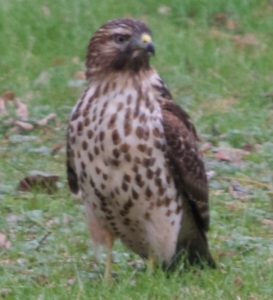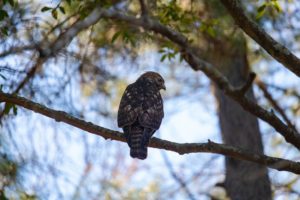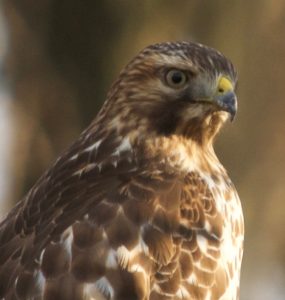Hello fellow readers, The podcast version of last week’s story about the Magical Trail of Renewal (Episode 63) includes the story of a robin family that once again took up residence in the Doublefile viburnum outside the kitchen window. The nest was higher in the oversized shrub than in previous years, likely because of Jolee’s joy in the chase— squirrels and chipmunks are her favorite, but robins work too. And, as it turns out, a Red-Shouldered Hawk.
The story of a Red-Shouldered Hawk
It was supper time. After our evening walk in the woods, Jolee on the hunt, a few tosses of a tennis ball, and a dunk to cool off in the brook, we came inside. The storm door remains year-round, so Jolee can continue her hunt through the glass – the screen door wouldn’t hold her back. As I was preparing her kibble, I saw her intent stare and looked out to find the Red-Shouldered Hawk below the viburnum.

Red-shouldered Hawk (Buteo lineatus) Photo Credit: Mike Niven
“No,” I yell, flying open the door, Jolee storming out behind me. The hawk takes off with expansive reddish-brown feathered wings. In-flight, you can see his black and white banded wing tips and tail feathers. Mr. or Mrs. Robin chased him from behind, comparatively demure in size but with immense bravery. Below the tree, Jolee snoops, indicating casualties. My heart sank. I call her inside.
The repetitive early morning squawks of a Red-Shouldered Hawk often wake us, especially when camping out on the screen porch. With the loud, high-pitched “kee-aah” call, the second note descends in tone. The call is to claim their territory and express alarm.
He’s magnificent looking, but after last year’s feast on the frogs in the pond and the nest of Blue Jays I grew to adore shifted my admiration. Seeing him as a predator to the robin family made me angry. Well, maybe not angry but sad. Yet it’s the cycle and balance of nature. There would be too many robins, jays, and frogs, perhaps without it. The justification doesn’t help.
Red-shouldered Hawks only occasionally eat birds.

Photo by Jonathan Larson on Unsplash
Per Cornell Labs All About Birds, Red-shouldered Hawks feed primarily on snakes, lizards, amphibians, and small mammals like voles and chipmunks. “They occasionally eat birds, sometimes from bird feeders; recorded prey include sparrows, starlings, and doves.”
So feast on the overabundance of chipmunks damaging the roots of plants in the rock garden instead of the easy pickings of baby birds–though chippers are cute too.
It’s interesting how we grow attached and wish to nurture the nests of young birds. And adore fawns until they grow to eat our gardens. But we don’t typically cherish insect babies— though most love the native ladybugs and butterflies.
Curt investigates the crime scene.
When Curt came home from work, I told the tale. He investigates the crime scene with Jolee and finds a decapitated robin.
“He looks like he was ready to fledge the nest.” Fully feathered and ready to fly. He buried the young bird next to the baby fox killed by a juvenile bear hunting for sport. Nature can be so cruel.
“We can prune the viburnum now,” I say.
The Doubelfile Viburnum has grown far taller than most. We manage the size and limb it up in the shape of a small multi-stem tree. I adore how the white flowers coat the branches in spring, attracting pollinators. Then they fall to the ground, gracing angel-shaped petals on the shade garden of ‘Palace Purple’ heuchera, Japanese Painted ferns and Hosta below.

Red-shouldered Hawk – Photo by Mike Niven
Red-Shouldered Hawks – Messengers of Vision
The following day, our first call with Jolee, we made our way into the woods, and in typical Jolee fashion, she was more focused on the hunt than the task at hand. No squirrels or chippers to chase. Only two robins were happily feeding on the forest floor, not concerned about our presence.
Jolee’s front feet poised on a log, her eyes following their short flights and bopping along the ground. The shadows made it tough to see if they were the fledging young with more speckled chests than their parents. Jolee stays steadfast. She didn’t go for the chase as if she knew they were from the nest she protected from the hawk. Maybe two survived. I want to think so.
The Cherokee believed “Red-Tailed, and Red Shoulder Hawks are messengers of vision. When you see one of these beautiful birds, whatever you were thinking about at the time is happening around you, or it will come true and manifest in your life.” (springwolf.com). I was thinking spare the robin family.
On our way back inside, I notice an Adirondack chair on the patio near the nesting spot covered in bird droppings, not so the day before. Perhaps evidence it served as the training ground for the brood learning to fly.
Garden Dilemmas? AskMaryStone@gmail.com (and on your favorite Podcast App.)
There’s more to this story in Episode 64 of the Garden Dilemmas Podcast
Link to the story about a nest of Blue Jays – Blue Jays Bad Reputation and Doublefile Viburnum Angels
For more about Red-Shouldered Hawks: https://www.allaboutbirds.org/guide/Red-shouldered_Hawk/id


